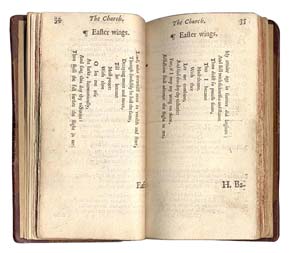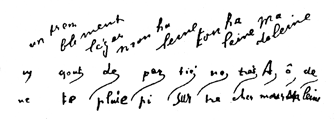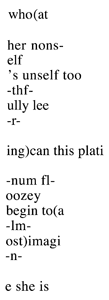| |
Below are three examples of concrete or pattern poetry that in some sense are precursory to ASCII art and which also have some relation to my own ASCII work:

George Herberts (1593-1633) Easter Wings, illustrated below, is an example of a Carmen figuratum or hieroglyphic formas popular in the 16th and 17th centuries. Like much of his poetry the subject is devotional. Content occupies the form of the poem in way analogous with the accommodation of the soul within the temple of the body and this coincides with the poems theme of bodily sickness and spiritual resurrection. The rules of syntax are only slightly qualified so that a winged form appears as a marvellous coincidence with the content of the poem.

EASTER WINGS.
LORD, who createdst man in wealth and store,
Though foolishly he lost the same,
Decaying more and more,
Till he became
Most poor :
With thee
O let me rise
As larks, harmoniously,
And sing this day thy victories:
Then shall the fall further the flight in me.
My tender age in sorrow did beginne:
And still with sicknesses and shame
Thou didst so punish sinne,
That I became
Most thinne.
With thee
Let me combine,
And feel this day thy victorie,
For, if Iimp my wing on thine,
Affliction shall advance the flight in me.

The extract below, from Guillaume Apollinaire's Le Troiseieme Poeme Secret, describes a trajectory rather than a total ising or recognisable shape. The poem's picture charts the rhythmic merging of two breaths as the poet sighs the name of his lover, Madeleine.
If any image emerges here, it is more like a diagram or schema than a picture of a thing. The sequence of the words and particularly the displacement of the syllables in this pattern poem resemble the crochets of a musical score, especially in the second double-line where the syllables are reconnected by the use of calligraphic flourishes.


In the poems of E.E. Cummings, single letters will often be the sole occupants of a line. Words are split by punctuation marks and sculpted into shapes that imply rather than explicitly describe recognisable objects. His poem CP704 is in the form of a single sentence asking a rhetorical question of a blonde-haired woman viewing her image in a mirror:

Hyphenation and parentheses are used to tease out this question - increasing the duration and the length of the sentence. the obstinate superfluity of punctuation here has the effect of forcing the eye to search for a foothold in every syllable - turning the sentence into an escarpment of semantic debris over which it has to clamber to comprehend meaning. By exaggerating its function, Cummings forces each character into a burlesque pose for its role in the sentence and thereby effects a sort of denuding of punctuation.
| |